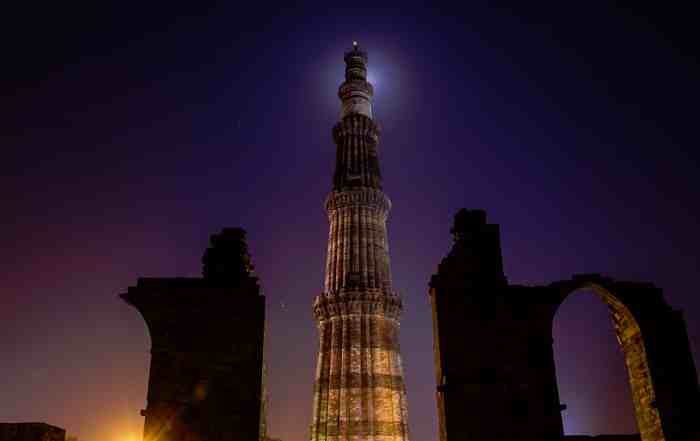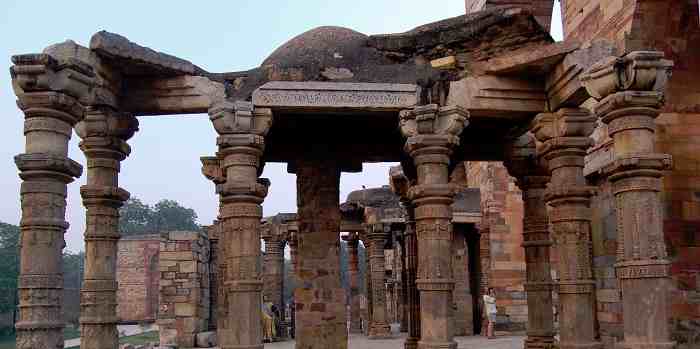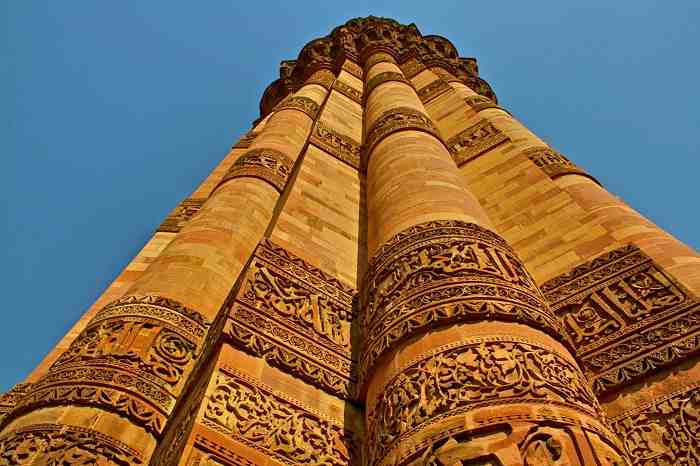When was it built: Construction started in 1192 and completed in 1220. Restoration works/additions were made in 12th century, 14th century and 19th century
Who built it: Qutb ud-Din Aibak, Iltutmish added 3 storeys, Firoz Shah Tughlaq carried out restoration work
Height: 73 m
Where is it located: Mehrauli in South West district of Delhi, India
Why was it built: As victory tower/ As minaret to the muezzins
Architectural Style: Indo-Islamic architecture
Visit Timing: Sunrise to Sunset
Entry Fee: Indian citizens: Rs. 30/- and for foreign nationals: Rs. 500. Entry is free for children up to 15 years of age.
How to Reach: By Metro - board from any DMRC station and reach Qutb Minar station and then follow rail map to reach the minar; by DTC buses; by Hop On Hop Off Sightseeing Bus Service offered by Delhi Tourism.

Qutub Minar or Qutb Minar, a 73 m (240 ft.) high tower made of red sandstone and marble is not only the highest brick minaret in the world but also one of the most famous historical landmarks of India. The construction of this tower of victory was started by the founder of the Mamluk Dynasty in Delhi, Qutb ud-Din Aibak and completed by his successor and son-in-law Iltutmish. Located in the heart of Delhi, India, this UNESCO World Heritage Site, visible from different parts of the city attracts thousands of visitors every day. It is one of the most popular tourist spots in India and a must visit tourist spot in the itinerary of first time visitors to Delhi, both national and international.
History of this Colossal Tower
Qutb ud-Din Aibak, the founder of the Turkish rule in north-western India and also of the Mamluk Dynasty in Delhi commissioned the construction of this monument in 1192 AD. Aibak dedicated the minaret to the Muslim Sufi mystic, saint and scholar of the Chishti Order, Qutbuddin Bakhtiar Kaki. Different beliefs surround the origin of the minaret. While some sources believe it was constructed as a tower of victory marking the beginning of Muslim dominion in India, some others say it served the muezzins who called the faithful to prayer from the minaret. Uncertainty hovers around naming of the tower with some suggesting it was named after the Sufi saint, Qutbuddin Bakhtiar Kaki while others believe it was named after Aibak himself.

Image Credit: easytoursofindia.com
The tower was completed by Aibak's son-in-law and successor Shams-ud-din Iltutmish, regarded as the founder of the Delhi Sultanate, in 1220. Iltutmish added three more storeys to the monument. This historical monument faced a few natural disasters. A lightning hit the top storey of the minaret in 1369 AD, knocking it off entirely. The then ruler of the Sultanate of Delhi, Sultan Firuz Shah Tughlaq took charge of its restoration and constructed two more storeys to the minaret made of marble and red sandstone. Again when an earthquake damaged it in 1505, the then Sultan of Delhi, Sikandar Lodi, reconstructed the top two storeys of the minaret with marbles. Parso-Arabic and Nagari characters engraved in various sections of the minaret speak about the history of its construction. The minaret faced the wrath of nature yet again when a major earthquake on September 1, 1803 damaged it severely. In 1828, it was renovated by Major Robert Smith of the British Indian Army, who installed a cupola atop the tower. However in 1848, as instructed by the then Governor General of India, Henry Hardinge, 1st Viscount Hardinge, the cupola was uninstalled from the tower and placed in the east of it where the cupola remains situated.

Image Credit: wlivenews.com/wp-content/uploads/2016/06/Qutb-Minar-1.jpg
Architecture of the Minaret
The 73 m (240 ft.) high tapering minaret has a base with diameter 14.3 m (47 ft.) and diameter of 2.7 m (9 ft.) at top. There are six storeys in the minaret with the first three constructed with red sandstone and the next three with sandstone and marble. A circular staircase of 379 steps allows one to reach the top of the tower to witness a panoramic view of the city. Verses from the Qur'an are etched on the bricks of the minaret that are covered with elaborate iron carvings. Each storey of the tower has a projected balcony surrounding the minaret and supported by corbels that are ornamented with Muqarnas or honey-comb vault, a type of architectural ornamented vaulting. The architectural styles developed over different eras starting from the time of Aibak till that of Tughlak as also the materials used in construction of different stages of the tower are conspicuously varied. The tower is tilted from 65 cm above the ground.

Image Credit: historicaltimeofindia.blogspot.com
The Qutb Complex
A number of monuments and buildings that are historically significant and associated with the minaret surround it and the whole area forms part of the Qutb complex. The structures inside the complex include the Quwwat-ul-Islam Mosque, the Iron Pillar of Delhi, the Tomb of Imam Zamin, the Tomb of Iltutmish and Major Smith's Cupola among others.
Of these the Quwwat-ul-Islam Mosque located at the north-east foot of the minaret holds significance as the first mosque that was constructed in India. Commissioned by Aibak, the construction work of the mosque started in 1193 and completed in 1197. This magnificent structure consists of an inner and an outer courtyard ornamented with shafts, most of which were taken from the 27 Hindu temples demolished to build the mosque. A provocative inscription carved over the eastern gate of the mosque records such information manifesting the presence of typical Hindu ornamentation in a Muslim mosque.
Another notable attraction inside the Qutb complex is the 7 m (23 ft.) Iron Pillar, a rust-resistant iron column that not only attracts tourists but also draws attention of archaeologists and materials scientists. This pillar from Gupta Empire has Brahmic inscriptions. It is commonly believed that if one can embrace the pillar with both hands while standing with one's back facing the pillar then his/her wish gets fulfilled.

Image Credit: armchairlounge.com
A Visit to the Historical Monument
The monument complex located in Mehrauli, Delhi, India, remains open to visitors all day from sunrise to sunset. Entry fees per person for Indian citizens is Rs. 30/- and for foreigners is Rs. 500/-. Entry is free for children up to 15 years of age. Although visitors were allowed to climb the staircase inside the minaret to reach its top, a severe accident on December 4, 1981, that killed 45 people and injured several others led authorities to restrict such access to general public. A masterpiece of the medieval age India, the Qutub Minar has over time remained one of the most popular tourist spots in Delhi, India and a recent collaboration with Archaeological survey of India has made it possible to have a 360o walkthrough of the tower.



